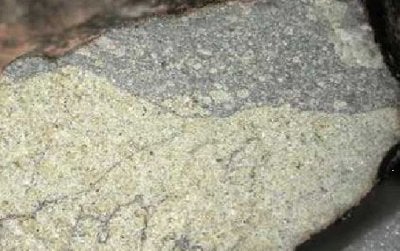A piece of the Moon found in Africa has the youngest date known for a lunar rock, 2.865 billion years. This age is several hundred million years younger than the youngest mare basalt and about a billion years younger than any other lunar rock of its kind.
The lunar meteorite known as Northwest Africa 773 (NWA 773) was found in September 2000 near Dchira, Western Sahara. Weighing about 1.4 pounds (633 grams), it is an impact breccia, a common type of Moon rock made of fragments of the lunar surface welded together by the shock and heat of a meteorite impact. The largest single fragment in the baseball-size meteorite is a chunk of olivine, a tiny piece of which was analyzed by a University of New Mexico team headed by Lars Borg. The team published their report in the November 11, 2004 issue of Nature.
He points to one region on the Moon as a source: “It’s very likely NWA 773 came from what’s called the Procellarum KREEP Terrane.” This is an area on the Moon’s western hemisphere with a unique geochemical identity, marked by rocks rich in potassium (K), rare-earth elements (REE), and phosphoros (P). It’s also the probable source region for another lunar meteorite recently studied, Sayh al Uhaymir 169, but the two rocks’ histories appear otherwise unrelated.
Soon after the Moon formed, planetary scientists say, the heat of continual large impacts created a global layer of molten rock — a magma ocean. “As the magma ocean cooled,” explains Borg, “various minerals began crystallizing in sequence. First came olivine, then pyroxene, then plagioclase feldspar. Plagioclase is light, so it floated to form an anorthosite crust. Finally, you get these last crystallizing dregs that don’t combine with the others. That’s the origin of KREEP.”
KREEP-rich rocks contain high concentrations of radioactive elements such as thorium and uranium. Says Borg, “The decay of these elements produces heat, so this could be the energy source for relatively young magmas such as we saw in NWA 773. If we found still younger rocks, we’d expect an even stronger KREEP signature.”
The Moon may have rocks younger than NWA 773, but they have not yet been found. “We’ve got material in our collections that are bits and pieces from all over the Moon,” says Borg, “but we don’t see material with very young crystallization ages. We may have young materials, but don’t recognize them — or perhaps they’re just not there.”










